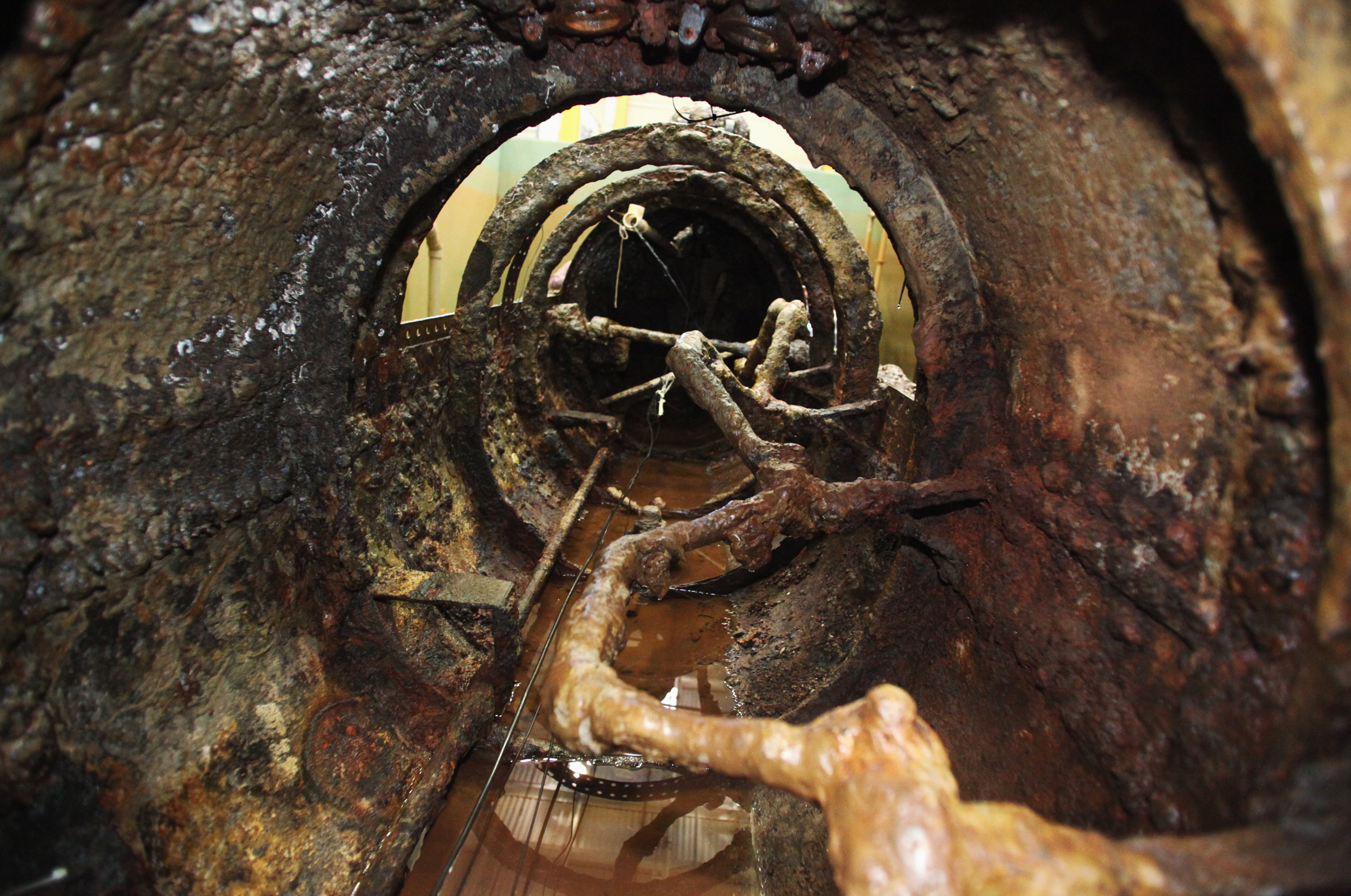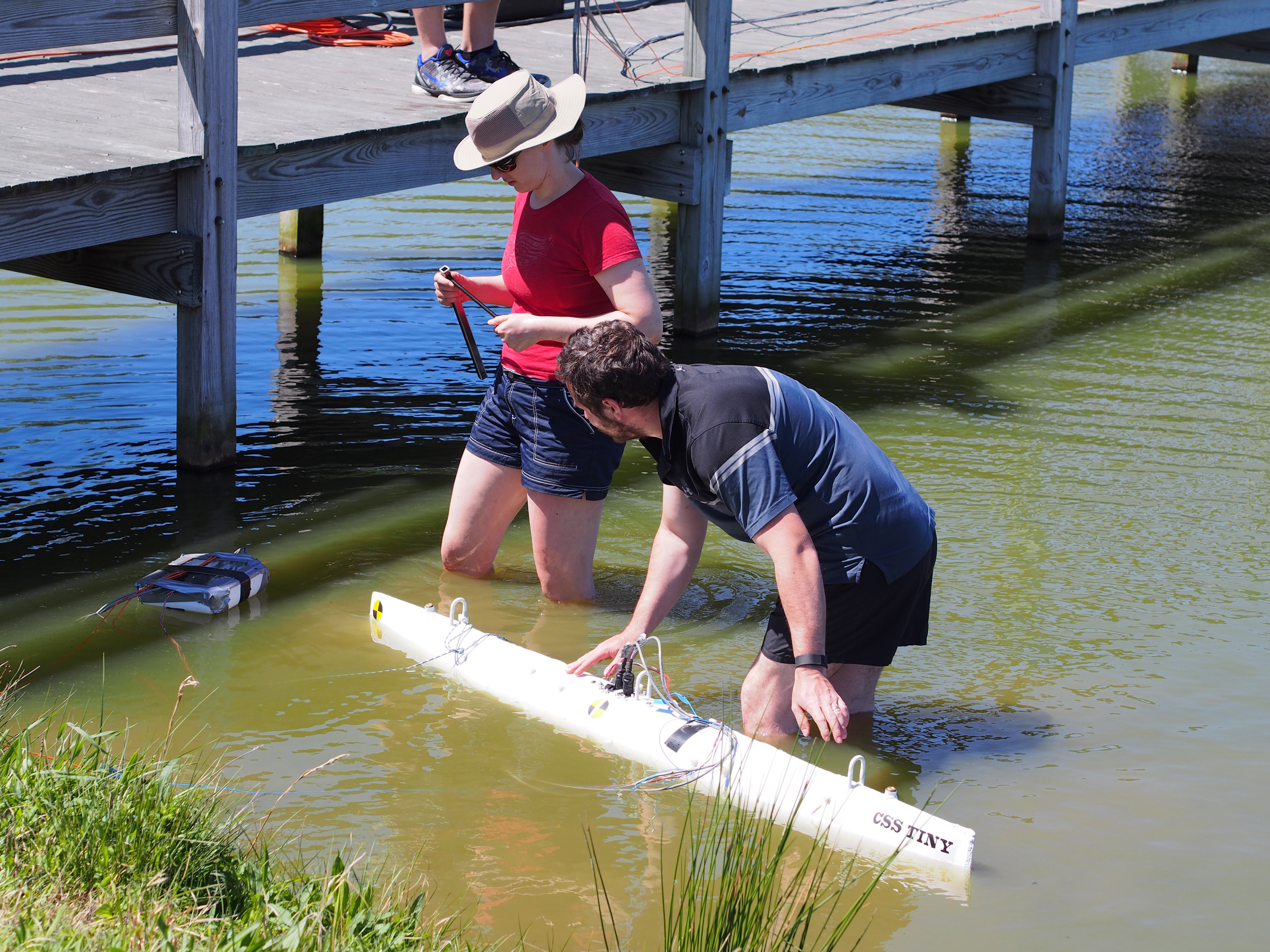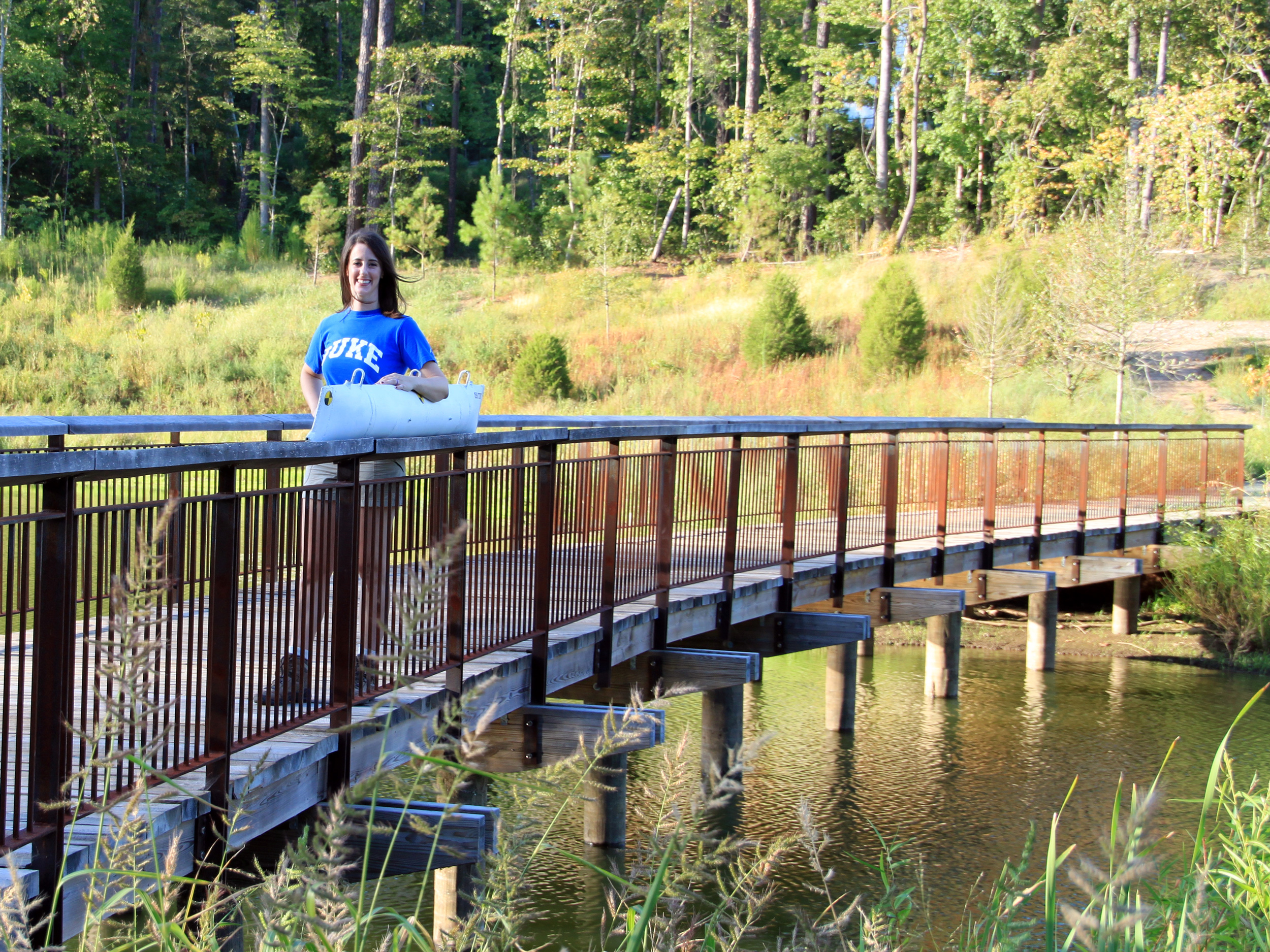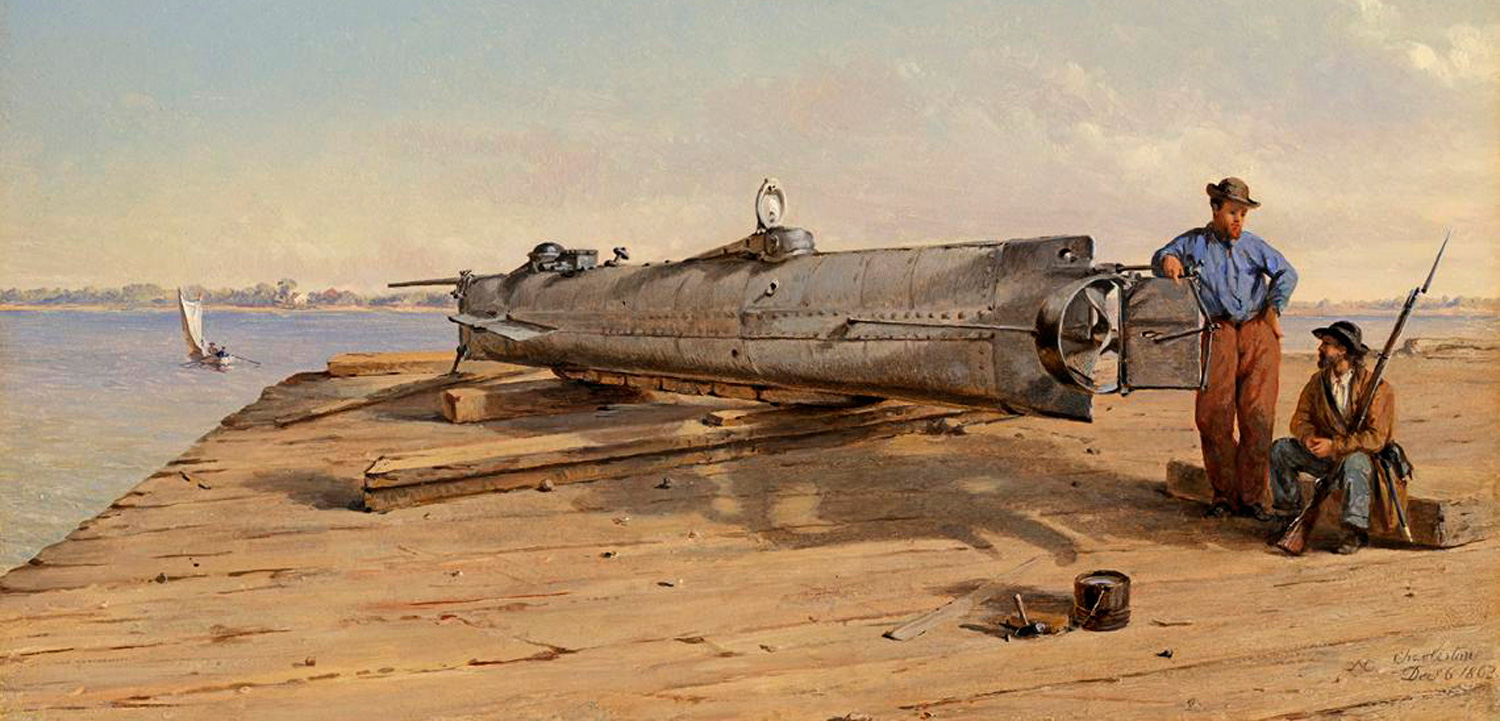Blasting Through the Hunley Mystery
A maverick scientist claims she has done what scores of researchers before her failed to do: solve the century-old mystery of why a legendary Civil War submarine sank.
Article body copy
Around 6:30 p.m. on February 17, 1864, eight men crammed into the Confederate submarine H. L. Hunley, a self-propelled metal tube attached to a bomb, and slipped quietly into the freezing black water off the coast of Charleston, South Carolina. The crew hand-cranked the sub more than six kilometers toward its target—the Union blockader USS Housatonic—and surfaced like a leviathan for the charge. By 9:00 p.m., it was over: the Hunley had thrust its spar-mounted torpedo into the Housatonic’s hull and within seconds, 60 kilograms of black powder had caved in the ship.
Just after the brief moment of glory, the Hunley, which had just become the world’s first successful combat submarine, mysteriously sank.
Its demise has baffled scores of researchers and Civil War buffs for more than a century. Now, one maverick scientist is making the bold claim that she has cracked the case. After three years of sleuthing, Rachel Lance, a US Navy biomedical engineer who holds a PhD from Duke University’s Pratt School of Engineering in North Carolina, concludes that the blast from the sub’s own torpedo sent blast waves through its iron hull and caused instant death for the eight men inside.

The H. L. Hunley, which is now held at Clemson University in South Carolina, had sunk twice during prior voyages before its mission to take down the USS Housatonic in 1864. Photo by Mic Smith Photography LLC/Alamy Stock Photo
If she’s right, the mystery of the Hunley may finally be put to rest. But how she made the discovery is almost as surprising as the discovery itself: she did it without access to the physical sub, which was excavated in 2000; without prior experience in archaeology or forensics; and without help from the Hunley Project, a team of researchers and scientists at Clemson University in South Carolina that has been on the case full time for the past 17 years.
Without collaboration or key pieces of data, could Lance’s account of the final moments of the Hunley and its crew be right?
On a warm September Saturday, I’m standing outside the student center at Duke, a low-rise contemporary building accented with the university’s signature neo-Gothic stone, when Lance swings around the bend in a blue Pontiac Grand Prix straight out of Motor City where she grew up. As I open the passenger door to introduce myself, I’m hit by a wall of thumping workout music. Lance just came from the gym, and her brown, shoulder-length hair is thrown up in an elastic. A blue, stonewashed T-shirt that reads Detroit rides up her pale, lanky arms.
As we make our way off campus, the music keeps pumping.
“Where are we headed?” I yell.
“I’m taking you to the campus pond to see where we ran some of our experiments,” she thunders back. “It’s quiet there so we can talk.”
Lance was modeling an underwater explosion at a computer in Duke’s Injury Biomechanics Lab, where she studied blast injuries, when her adviser had the epiphany that set her Hunley obsession in motion. What if, biomechanical engineer Dale Bass suggested, the modeling software could virtually reconstruct the attack on the Housatonic and reveal insights into the fate of the Hunley? Lance, a history buff, was hooked: a historical mystery with a tantalizing lead to follow. Eventually she’d abandon the software for a more hands-on experimental approach, but Bass’s idea was the catalyst she needed.
She began reading theories about why the Hunley went down. One prevailing idea was that the crew ran out of oxygen and suffocated. It was exactly the type of theory she was poised to tackle: she’s been a civil service engineer with the US Navy since 2009 and has expertise in breathing system dynamics and, more specifically, rebreathers—the closed-circuit breathing systems divers use to recycle breathing gas underwater.
As her investigation got underway, Lance noticed there was very little, if any, published research on the crew’s oxygen consumption during the mission. With the navy, she had researched the phenomenon of how much oxygen people used while operating hand-pedal ergometers requiring the same type of motion as the Hunley’s hand-cranked propulsion system. So, she dug up the data and used it to calculate how much oxygen the crew would have used while cranking their way toward the Housatonic.

A 1900 edition of Popular Science Monthly included this depiction of the cramped quarters within the H. L. Hunley, which we have animated. While nine men are shown here, the Hunley is believed to have had an eight-man crew the night it sank in 1864.
It wasn’t clear how much oxygen there was to begin with though. After hauling up the sub, the Hunley Project conservators calculated how much air was likely available. Their data suggests the crew had enough air for little more than two hours. Lance, however, didn’t have access to the actual data. She had met with project members to discuss collaboration, but they wouldn’t share their calculations with her (and, later on, would ask Lance to sign a non-disclosure agreement, which she’d decline). She’d have to go her own way.
She mulled over the problem for days. Then, she remembered thumbing through a newsletter published by Friends of the Hunley, a nonprofit in Charleston that handles outreach, fundraising, and development for the Hunley Project and runs tours at Clemson’s Warren Lasch Conservation Center where the Hunley is being restored. It was filled with interior and exterior photos of the sub, most of which had measurement notations below them. That gave her an idea.
For the next month, Lance sat hunched over her desk printing out photos of the sub, measuring each demarcated point with a ruler. After weeks of painstaking work, she finally had all the measurements necessary to calculate oxygen consumption versus supply. The results leapt off the page. Suffocation was not a plausible explanation for why the Hunley sank.
“Even with conservative calculations, the crew would have been experiencing noticeable hyperventilation, gasping for breath, choking, symptoms of panic, and likely physical pain from high levels of CO2 in the blood,” she says. “But we also know from records that they were seated peacefully at their stations without any signs of struggle. So, from my perspective, this tossed the suffocation theory out the window.” The findings were published in the March 2016 issue of the journal Forensic Science International.
Richard Moon, the medical director of the Duke Center for Hyperbaric Medicine and Environmental Physiology, agrees. He helped Lance run the calculations and says, “You have a bunch of submariners who were working moderately hard in an enclosed space. There’s no way they would be working away at the crank in a 10 percent oxygen environment with high levels of CO2 and say, ‘Oh well, things are fine; we’ll just keep on going.’”
The folks at Clemson weren’t convinced. Kellen Correia, president and executive director of the Friends of the Hunley, stated in an email that, “It’s premature to draw any final conclusions about the causes of the loss of the submarine or death of the crew, especially when looking at only one aspect of the situation.” She didn’t, however, reference any specific issues with Lance’s findings.
Debunking the suffocation theory offered Lance some short-term satisfaction, but by this point, she was in deep. She began thinking about the Hunley around the clock, obsessing over it to the point where she’d zone out and stare into her plate of food during dinner with her fiancé. “There was something viscerally terrifying about the fact that eight people died that night, and we had no idea how or why,” she says.
In the meantime, Hunley Project conservators at the Warren Lasch Conservation Center were chiseling—and continue to chisel—their way through the stubborn, concrete-like layer of sand and silt that formed around the Hunley as it sat on the seafloor for more than 100 years.

On their last evening, the H. L. Hunley crew members sat here, side by side, slowly hand cranking their way toward their target. Photo by Randall Hill/Reuters
“The de-concretion has the opportunity to give us more information,” says Clemson archeologist Michael Scafuri, “but we haven’t uncovered any definitive evidence to completely explain the loss of the Hunley. Nothing in and of itself explains what happened.”
There hasn’t been any case-cracking evidence on the human remains side, either. Linda Abrams, a forensic genealogist who has been working on and off with the Hunley Project since 2006, says all of the crew member skeletons were in good shape when they were excavated from the Hunley’s interior. The sub was completely filled with sediment when it was salvaged, so layer upon layer of muck had to be carefully removed before the bones were exposed. “There were no bullet wounds in any of these guys,” she says. And no signs of desperation.
While the scientists haven’t come up with a smoking gun, there is a small area of damage to the sub’s exterior that has stumped them. The forward conning tower has a softball-sized chunk of iron missing where a viewport had been.
Through her research, Lance learned of the damage to the conning tower and the so-called lucky shot theory: a stray bullet fired by Housatonic sailors during the attack punctured the tower, causing the sub to fill with water and sink.
From Scafuri’s perspective, it is a possibility. “The gunfire from the Housatonic may have played a role in this,” he says, “but we cannot confirm that at this point.”
Lance tested the theory by shooting Civil War-era firearms at cast iron samples—the damage to the sub was inconsistent with damage from her rifle fire. Plus, she says, a bullet hole would have allowed water to rush into the sub quickly and caused it to sink much closer to the attack site than where it was found.
Based on her results, Lance crossed the lucky shot theory off her list and documented the findings in a second paper in Forensic Science International.
The Friends of the Hunley declined to comment on the specific findings, but Correia wrote, “Again, Ms. Lance doesn’t have any primary knowledge or data of the Hunley Project.”
Lance pressed on. If the crew hadn’t suffocated, and a bullet hole didn’t sink the sub, what did happen?
When the Hunley took down the towering Housatonic, it was less than five meters away from the blast. And, it was still attached to the torpedo; inspired by Confederate steam-powered torpedo boats known as Davids during the Civil War, the Hunley’s crew had bolted the sub’s torpedo onto the end of its spar. This meant the same explosion that rocked the Housatonic could just as well have meant lights out for the Hunley crew.
Lance had spent the better part of two years investigating the suffocation and lucky shot theories, published twice, and still hadn’t solved the mystery. For her, this explosion theory was the next obvious avenue to explore, and one that meshed well with her injury biomechanics focus at Duke. If a blast wave from the explosion propagated into the interior of the sub, she reasoned, it could have immediately killed the crew or at least injured them sufficiently that they would have been unable to pilot the boat to safety. “When blast waves hit an air space, they slow down like a car hitting a wall,” she explains. “Except in this case, the wall is the surface of the lungs.” The sailors’ lungs could have ruptured and filled with blood.
To test the theory, Lance needed a physical model of the sub. Enter the CSS Tiny, a scale model a sixth the size of the tour bus-length Hunley. Made out of sheet metal, it was a Hunley mini-me right down to ballast tanks filled with water and a steel spar mounted to the bow.

At a farm in rural North Carolina, Rachel Lance and one of her assistants, Luke Stalcup, prepare the CSS Tiny to receive explosions to test her blast wave theory. Photo by Denise Lance
Engineering a miniature submarine wasn’t a stretch for Lance, who grew up working on old cars with her father, a now-retired GM autoworker. As a kid, she was small enough to slide under their 1966 Mustang to change the oil without jacking up the car. “Growing up around car culture makes it easy to fall in love with machinery and engineering,” she says.
A few minutes after peeling away from campus in Lance’s Pontiac, we pull into a dusty lot at the Duke University reclamation pond. The thumping bass line cuts out abruptly and the soundtrack is replaced with the ratchet-like chorus of crickets. At the pond’s edge, she gestures to the water, thick with algae: this is where the Tiny took a test run. Lance and a few members from her lab used blast simulation devices known as shock tubes to test the Tiny’s pressure gauges and other equipment in advance of the live explosives phase of the experiment. As she stood in the water, raising and lowering the shock tubes, fish chomped at her legs. It was as if she was being repeatedly stabbed with tiny knives—but by the end of it, Lance and the Tiny were ready for the big event.
The campus pond was off limits to real explosives, so, two weeks later, Lance and her research team trekked out to a three-hectare pond on a rural North Carolina farm for the live ammo tests. They parked the Tiny in the middle of the pond, and with an explosives agent standing guard, the stage was set. Lance began the countdown: “Five! Four! Three! …” The culmination of months of hard work all came down to the next few seconds, and her nerves were frayed as she frantically clicked between sensor readout screens on her laptop.
From a safe distance, farmer Bert Pitt and his grandchildren were ready for the show. Lance had sweet-talked him into volunteering his pond for the project. “When Rachel came out to the farm,” says Pitt in a thick southern drawl, “she tried to butter me up with red velvet cake and explained that it would only be a one-sixth-scale explosion.”
“Two! One!” Pfffsssssttt! The black powder charge exploded on the Tiny’s spar, and a small geyser of pond water erupted. Pressure gauges hung inside and outside the vessel to measure the underwater blast waves. Below the surface, the explosion jetted a blast wave into the Tiny’s hull with so much force that it caused the metal to flex. That motion, in turn, generated a second blast wave that transmitted straight through the hull into the cabin.
Rachel Lance and her assistants test the CSS Tiny’s gauges with shock tubes at the Duke University reclamation pond in North Carolina. Courtesy of Rachel Lance/Duke University
“The secondary blast wave from this would have easily caused pulmonary blast trauma that killed the whole crew instantly,” Lance says. “This is what sank the Hunley.”
Moon supports the conclusion. He says most people would assume that the cabin walls would have protected the crew from the blast waves—but few people know much about underwater explosions. “Speculation up to this point has been fine,” he says, “but when you hold it up to hard science, I think the blast wave theory is the most plausible explanation.”
While Lance believes the mystery of the Hunley can finally be put to rest, the Hunley Project scientists aren’t ready to jump to conclusions. They’ve acknowledged the explosion theory as a possibility in the past, but began to doubt it prior to Lance’s experiment based on results from a computer modeling study conducted by the US Navy in 2013. The study suggests the blast wave would not have harmed the crew, yet further studies continue to second-guess any previous study conclusions.
“The problem is, it’s a complicated scenario,” says Scafuri. “It’s sort of like trying to reconstruct the causes of a car accident with limited information. Would you be able to find evidence of an accident that happened because a bee flew in through the window and distracted the driver, who happened to be texting, on a stretch of road that was slick?”
“Oh, I have something for you,” says Lance at Duke’s reclamation pond. She reaches into her backpack and hands me a cigar-sized, 3D-printed replica of the Hunley—a souvenir of sorts. It offers a micro, yet detailed, view of the sub’s interior that makes me realize how confining the crew compartment—which at full-scale was only one meter wide and 1.2 meters high—must have been for eight grown men. It was a death trap. The fact they crammed themselves into the tube anyway was a sacrifice Lance seems to have unwavering respect for. It’s part of what drove her to press on to the finish line, despite the odds being stacked against her.

Rachel Lance stands with her model of the H. L. Hunley—the CSS Tiny—at the Duke University reclamation pond. Photo by Eric Wei
But how could it be that Lance was able to unravel a century-old mystery in such a relatively short period of time, particularly given the Hunley Project’s 14-year head start? Was it beginner’s luck, or her ability to approach the problem from a different scientific vantage? Maybe it simply came down to old-fashioned determination. “You have to deal with a lot when doing this kind of research, especially when you’re doing things on your own, which can be difficult and lonely,” she says. “You need to have a lot of perseverance, because that’s where the good stuff is—past that limit where nobody’s been able to push through the problem before.”
In the end, maybe it had more to do with the fact that the Hunley Project is intent on both carrying out the painstakingly slow process of conserving the sub and explaining its disappearance. Although, from a revenue perspective, the mystery in and of itself may be a real positive for the Hunley Project and Friends of the Hunley, considering the sales of T-shirts, shot glasses, and lab tours it helps generate.
Regardless, when Lance’s findings from her blast wave experiment are published*, the Hunley Project team will be watching.
This time, it will be their theory to disprove.
*The findings from Rachel Lance’s blast wave experiment are now available in PLOS ONE.

